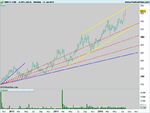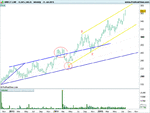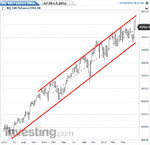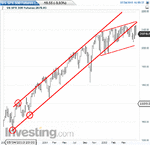dbphoenix
Guest Author
- Messages
- 6,954
- Likes
- 1,266
What a good idea 😆
Let me offer a question: What happens when you are looking at an accelerating trend rather than a flattening one and when it then starts flattening where do you draw your trend line from?
Depends on the bar interval and the timeframe. If one is using a weekly interval and using the last departure in November '12, then there's been no change in the trendline. So far.
However, if one is looking at supply/demand lines, which are quicker to track demand/supply imbalances within the overall trend, it's a matter of the line being broken, in which case one is looking at either a reversal or a shift to ranging.
For example, if you look at p. 11, you'll see that price has reached the upper limit of the weekly trend channel. The weekly trend is still up, but that doesn't mean there are no counter-trend trades. Those are some of the potential tactics in trading a channel.
In any event, if you look down at the hourly, you'll see that the demand line is broken once price reverses off the upper limit of the weekly channel. At this point, you either have a reversal or you move sideways. Here you have both, but you can't know that in advance. So once this line is broken, you go for the reversal. When this doesn't work out either, you take the long, according to the rules, as you have no way of knowing whether or not price will exit the upper limit of the channel and change course again.
If you then look at the chart on the next page, you'll see that price finds R at that last swing high, which is also the upper limit of the trend channel. Once the demand line is broken, one takes the short.
And, yes, it seems like a lot of in-and-out, but if the trader has no idea what he's looking at, then a rules-based approach is the preferred course. Most would rather resort to indicators, which is fine, but that's not what trading price is all about. The advantage of this particular approach is that (a) losses are strictly contained and (b) the trader is not allowed to exit a winning trade just because he feels like it.





